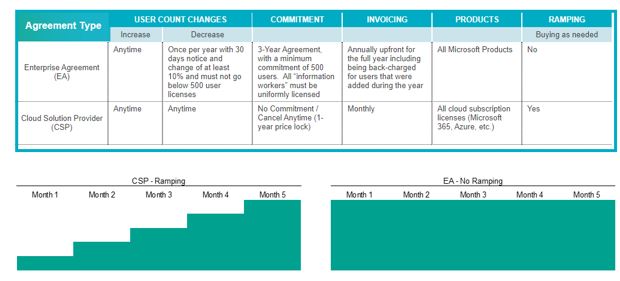It is essential for organizations using Microsoft solutions to stay on top of and understand Microsoft’s licensing terms and pricing changes and get a grasp on how they will affect the organization’s compliance and cost. However, navigating Microsoft licensing can be overwhelming. How do you buy licenses today? How often can changes be made? How should licenses be purchased? No matter the size of the organization, buying some or all licenses through a Cloud Solution Provider (CSP) may be the best option.
In this blog, we explore what a CSP is, the differences between an enterprise agreement (EA) and a CSP, why cloud licensing does not always equate to compliance, limitations of a CSP and when a CSP make sense versus an EA.
What is a Cloud Service Provider?
CSP was introduced by Microsoft a few years ago and offers an alternate option for buying Microsoft licenses. CSPs can sell all cloud licensing including Microsoft 365, Dynamics 365 and Azure to commercial, government, non-profits and education. Inclusive of the license, partners can also offer services wrapped around those licenses and it should be noted that organizations can buy from multiple licensing vehicles and CSPs. Working with a Dynamics partner? Buy Dynamics licenses from them. Working with an Azure partner? Buy Azure from them, even if an EA is in place.
CSP vs. EA
Understanding the differences between a CSP and an EA can provide flexibility and price benefits. It is important to note that having an EA does not mean that a CSP is not a potential, either as a replacement or as an additive. Let’s take a closer look at two different buying groups: Enterprise clients generally have over 500 employees and smaller organizations have up to 500 employees.
Enterprise clients will usually work with their Microsoft account team and enter a three-year (and sometimes four- or five-year) Enterprise Agreement (EA), but there are some exceptions when another option may be a better fit. Enterprise clients do benefit from volume discounts, and there are four levels or bands of enterprise clients, depending on size. Microsoft measures size based on the origins of the company being tied to Windows and Office. Users that would be a target for Windows and Office are classified as knowledge workers, so the pricing levels are based on the number of knowledge workers. These users are what an EA was created for, as all knowledge workers are intended to be equally licensed on “enterprise” products (i.e., Microsoft 365), thus enterprise agreement as the name. Users also benefit from access to training and vouchers although the voucher program is currently being phased out and with the explosion of online free training videos (often by Microsoft), the training benefit is also diminishing. This means the real differences between an EA and CSP come down to only price and a few other potential considerations we will cover later.
CSP considerations
There are limitations of a CSP that are important to keep in mind. CSP was created for a cloud-only world, which means that historical licensing is not supported by a CSP. For example, an organization that has a Windows Server with Software Assurance (SA), which also has SQL Server with SA, could not simply move to a CSP if the desire is to eliminate the existing EA. CSPs currently also have limitations on some device licensing (i.e., Microsoft 365 E3 Device based). Multinational companies have additional considerations with a CSP based on countries in which they can sell.
When is it appropriate for enterprise organizations to consider a CSP?
- Enterprise clients that need a product for a small group of people or for a limited time (recall an EA is to have everyone licensed equally)
- Projects occasionally have a defined timeline and licenses may be needed just for that duration. CSP is a great way to augment licensing without getting locked into a longer term. This is also a great way to do a POC before launching fully into a purchase.
- Mergers and acquisitions, or divestitures
- Occasionally, licensing must be acquired quickly and negotiating enterprise agreements takes time. A client can be established within a few days with a CSP. Recently, Protiviti helped a client who was divesting from their parent company with an Azure subscription. They knew they were working towards an EA but they needed a solution fast. Their Azure CSP lasted just over a year before they moved everything to the EA.
- The organization is on track for an EA but wants to ramp up to it over time
- With an enterprise agreement, all licenses are purchased on day one. Occasionally, organizations have a multi-phased rollout plan before everyone is onboarded. CSP allows licenses to be added at any time as groups are onboarded.

- Hesitation on a three-year commitment
- Three years is a long time in business! CSP provides the flexibility to increase and decrease the license count at will and cancel at any time without penalty.
CSP is a great licensing option for a smaller business too. It offers maximum flexibility and ability to manage costs based on needs.
The advantages of buying through a CSP include:
- Ability to increase and decrease license counts at any time. This could be particularly helpful for a client that increases headcount for a short time each year, such as during the holiday sales rush, or for a summer intern group. This is in contrast to the enterprise agreement that was built to be a multi-year commitment where licensing can only be reduced once annually with 30 days’ notice and a drop of at least 10 percent.
- Ability to add and remove licenses at any time. Have a team interested in trying out a new license? Maybe some Power BI Pro licenses? Buy a few for your proof of concept, then add more or cancel at any time.
- Easy monthly billing (accounting for monthly adjustments).
- Quick turnaround. After completing the paperwork, Microsoft licenses can be available within hours.
- Buy licenses and services from one company, building trust.
In the end, understanding and using licensing to meet business needs can bear fruit in flexibility and price. It is always best to be well-informed before making decisions. It is also important to recognize Microsoft is constantly changing licensing. That could be in price, capabilities, bundles, buying vehicles or product use rights. It may be impossible to talk about Microsoft without talking about licensing, but the intent is to be flexible enough to respond to the changing needs of the business.
To learn more about our Microsoft consulting solutions, contact us.






